Costus, Mu Xiang 木香Mu Xiang (‘Wood Fragrance’) (TCM)Kuth, Kushta (Ayurveda) Koddam (Siddha) Qust, Qust Shirin, Kuth (Unani) Ru Rta རུ་རྟ (Tibetan) |

|
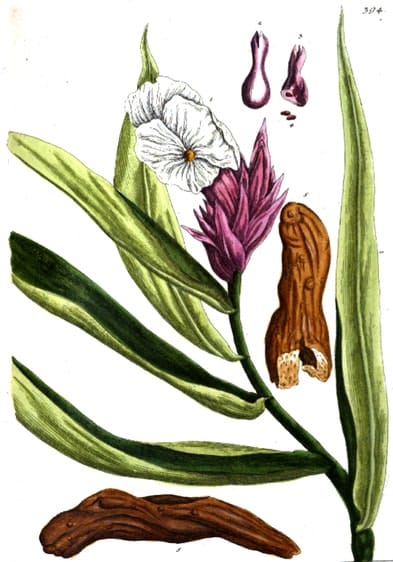 Sweet and Bitter varieties of Costus
Sweet and Bitter varieties of Costus(This is not Saussurea lappa)
Herbarium Blackwellianum, 1757
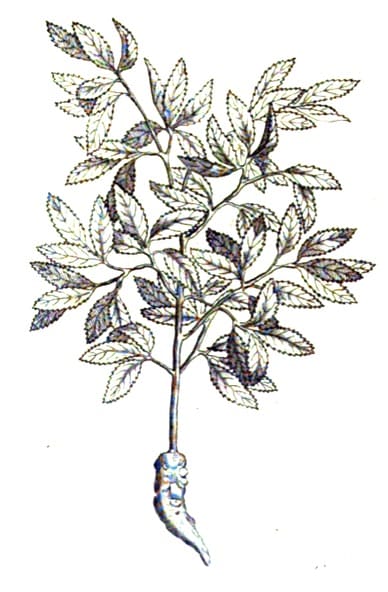
|
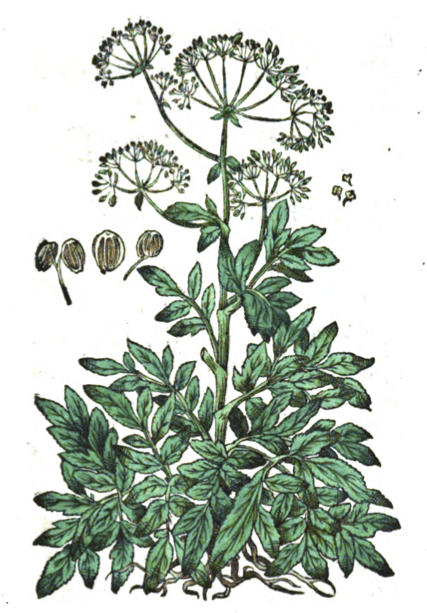
|
|
Arabian Costus A Complete History of Drugs, Pomet, London, 1748 |
Pseudocostus Kreutterbuch, Matthiolus, 1586 |
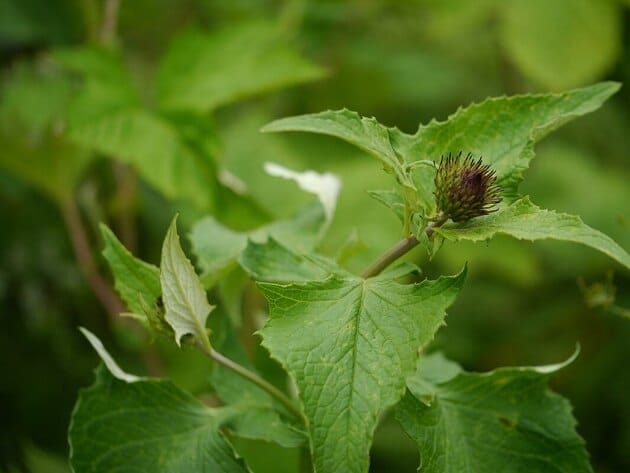 Saussurea costus
Saussurea costus(Photo by Dinesh Valke) (Wikimedia)
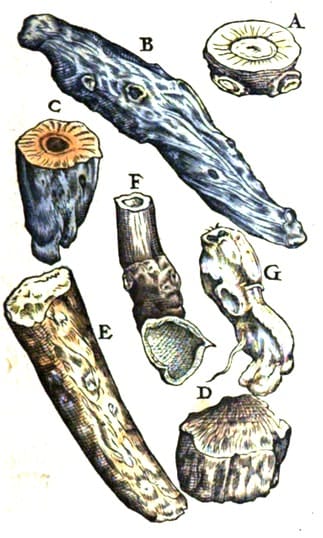 Herbarium, showing various Costus types, A. Bitter Costus;
Herbarium, showing various Costus types, A. Bitter Costus;B. Sweet Costus; C and D, Another Costus; E. Costus iridem;
F. Costus stem / root crown; G. Arabian Costus
(Kreutterbuch, Matthiolus, 1586)
 Aromaticum et Simplicium Aliquot, de Orta, 1579
Aromaticum et Simplicium Aliquot, de Orta, 1579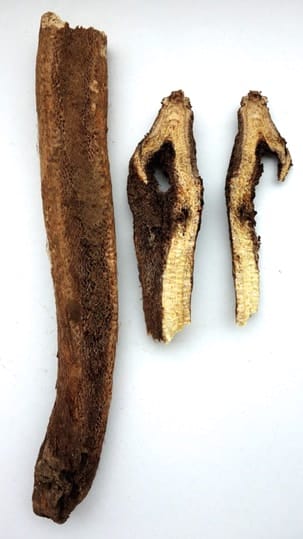
|
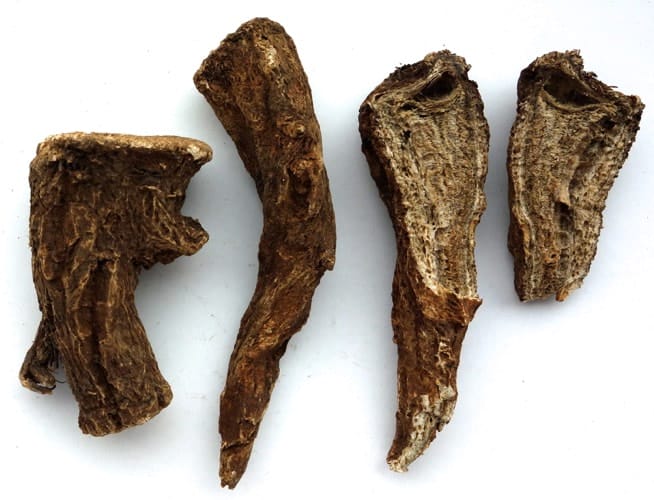 S. lappa from Yunnan (Yun Mu Xiang) (Adam, 2016)
S. lappa from Yunnan (Yun Mu Xiang) (Adam, 2016)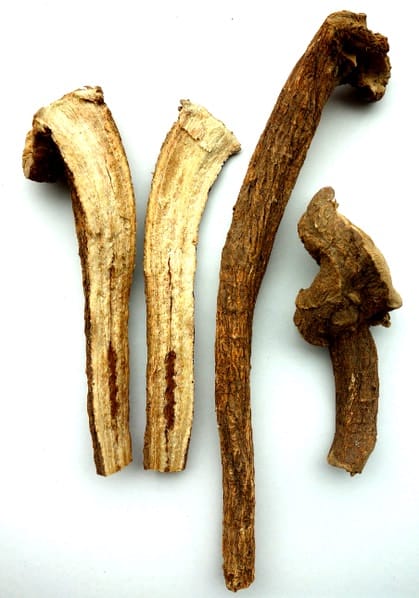
|
|
Vladimiria souliei (Chuan Mu Xiang) (Adam, 2016) |
Costus root used in Tibetan Medicine (Zang Mu Xiang) (Adam, 2016) |
Botanical name:
Saussurea lappa (syn. S. costus, Aucklandia lappa, Dolomiaea costus) (Official)
Sources for Costus (Mu Xiang) are varied and complex; alternate species used in TCM include:
- Inula helenium, I. racemosa (Tu Mu Xiang; used in India)
- Jurinea souliei (Chuan Mu Xiang; used in Sichuan, China)
- Dolomiaea soulei (syn. Vladimiria souliei), D. denticulata, D. berardioidea, D. platylepsis, D. edulis (Chuan Mu Xiang)
- Aristolchia debilis, A. contorta (Ching Mu Xiang); no longer used due to its toxicity.
Arabian, Bitter and Sweet varieties were traditionally known in the West, but only the Arabian (S. lappa) was commonly available in Europe, and was regarded as best. The Arabian was said to be heavy, ashen colored, hard to break, with a strong smell and aromatic taste and a little bitterness.
The varieties available in the West included:
- Arabian, White, Sweet, or Ancient Costus: Saussurea lappa (best)
- Indian, Black, or Bitter Costus: Inula racemosa (some sources say Orris)
- Syrian Costus: heavy, dark with an overpowering scent (lowest quality)
Some authorities (Dymock, Pharmacographia Indica, 1893; Khare, Indian Herbal Remedies) have stated Sweet Costus of the Arabs is Orris root (Iris germanica) which is also listed in Hamdard (Unani) publications.
Tibetan Medicine also recognises a ‘White’ (Vladimira) and ‘Black’ (Saussurea) type of Costus.
Parts used:
Root
Temperature & Taste:
Warm, dry. Pungent, Bitter, Aromatic.
“Hot in the third and dry in the second degree” (Avicenna)
Classifications:
2A APERIENT. 2B ATTENUATERS. 2C INCIDER. 2G. CLEANSING. 2H. CARMINATIVE. 2I. ANTISPASMODIC. 2Q. ANODYNE. 2S. STRENGTHENING. 2U. SUPPURATIVE
3C. ALEXIPHARMIC. 3D. CORDIALS & CARDIACS. 3E. DIURETIC. 3G. EMMENAGOGUE
4c. CARDIAC. 4e. STOMACHIC. 4g. HEPATIC. 4j. NERVINE. 4k. ARTHRITIC
TCM:
J. Regulate Qi
Uses:
1. Benefits Stomach and Intestines, Moves the Qi: (TCM, Ayurveda, Tibet, West)
-benefits the Stomach; poor appetite and digestion
-abdominal distention and epigastric pain (TCM, West, Tibet)
-colic, abdominal pain; Hernia
-Hiccups, Belching, Bloating
-Food Stagnation
-Diarrhea with Spleen deficiency or Cold and Damp
-with Tonic herbs to prevent their heavy, rich nature from causing stagnation
2. Moves Qi, Opens Obstructions: (TCM, Ayurveda, Tibet, West)
-pain over Liver and Gall Bladder; Tumors of the Liver
-Gall stones, Cholecystitis, Jaundice
-Chest, abdominal or Epigastric pain
-“Costus is useful for all the organs requiring warmth and absorbs humours from deep parts of the body.”. (Avicenna)
3. Clears Wind and Damp: (Ayurveda, Tibet, West, TCM)
-Rheumatism and Wind diseases including Paralysis
-Urticaria, skin eruptions, promotes Complexion (Ayurveda)
-promotes Urine, clears Edema
-“Relieves pain and Cold in the Urinary Bladder”. (Da Ming)
4. Resists Poison: (Ayurveda, Tibet, West, TCM)
-Malaria, Cholera, Leprosy, Diphtheria
-Scorpion Bites; bites of Viper (Dioscorides, Avicenna)
-used in Antidotes
-“disperses invasion of pathogenic factors, toxin and evil things”. (Shen Nong Ben Cao)
5. Moves Qi, Clears Phlegm, Stops Cough: (Ayurveda, Tibet, West, TCM)
-spasmodic Cough, bronchial Asthma, chronic Bronchitis (mostly in Ayurveda)
-Pneumonia (Tibet)
-Chest Pain from stagnation of Qi and Cold
-“disperses stagnant Qi in the Lung”. (Zhang Yuan Su)
-“purges excess in the Lungs”. (Ben Cao Gang Mu)
6. Regulates Qi, Strengthens Brain and Nerves: (Ayurveda, Tibet, West, TCM)
-Unani texts say it is tonic for Heart, Liver and Brain
-Some sources have regarded it as Tonic and Aphrodisiac in Ayurveda, Tibetan Medicine and TCM
-taken with Honey, it is Aphrodisiac (Dioscorides); Avicenna said taken in wine to vitalize sexual powers.
-Mental disorders associated with Wind or Qi stagnation (Ayurveda); psychosomatic, neurological disorders
-Hemiplegia, Paralysis (Ayurveda, West)
-promotes Intellect, rejuvenates
-said to turn grey hair black in both West and TCM (Porter Smith)
-“It relaxes the Nerves” (Avicenna)
-“strengthens will power … Long-term use prevents nightmares”. (Shen Nong Ben Cao)
7. Moves the Qi, Promotes Menstruation
-Amenorrhea; Menstrual Pain
-“provokes the courses, helps to cleanse the Womb from impurity, and helps Conception”. (Pemell, 1652)
-old TCM texts list it to prevent Miscarriage
-“Soothes the Fetus”. (Da Ming)
-“Useful in torn muscles”. (Avicenna)
8. Kills Worms:
-especially Broad-worms (Pemell, 1652)
–Gu syndrome (due to Parasites and Worms) (TCM)
9. Externally:
-oil of Costus is good for Cold and Weak Muscles and Sinews, Sciatica, Arthritis
-compound Oil of Costus; strengthens Nerves, Muscles and Tendons; applied to the Spine in Fevers; also for Colic, Pains; prevents Grey hair
-“often used to make bathing water by boiling the drug in water”. (Tao Hong Jing)
-decoction makes a good hair wash to strengthen the hair
-Wounds, Ulcers, Ringworm, chronic Skin Diseases and Tumors (ointment or paste)
-powder is applied to dry moist Sores, Wounds and Ulcers (Avicenna, Pemell)
-headache, mixed with powder with oil and apply to the forehead (Unani)
-powder is applied to Toothache
-as a fumigant or incense during Infectious diseases to prevent infection
-powder with water and honey is applied as a paste to skin discolorations and blemishes, Freckles, Vitiligo, Leucoderma (Unani, Pemell)
-Uterine Pain, it is used in pessaries or douches (Avicenna)
-as a cosmetic; smeared on the skin with water or honey (Avicenna)
-repels moths and insects from clothes if kept with them
Dose:
1. Taken with Wine to move the Blood, ease pain and open Obstructions. (West, TCM)
2. Taken with Wine and Honey to cure Poison and Venom.
3. Taken with Honey, it is aphrodisiac (Dioscorides). Also with wine for this purpose.
4. The unprepared root is best to move Qi; the stir-fried root is best for Diarrhea and diseases of the Large Intestine.
Powder: 1–3 grams;
Decoction: 2–6 grams, up to 9 grams
Comment:
Some older writers considered Costus to have tonifying effects: “When the drug is assisted by tonifying drugs, it has the function of tonifying. When used together with a purgative as a principal drug, it becomes a purgative too.” (Wang Ji, from Ben Cao Gang Mu)
Corrective:
1. Aniseed
2. Rose Conserve
Substitutes:
1. The Costus we have from TCM and Ayurvedic sources can generally be used for Sweet and Bitter Costus.
2. Elecampane; Inula racemosa, I. royleana have also been used
3. Zedoary (Pharmacopoeia Augustana)
4. Angelica
5. Gentian
6. Carduus nutans (reportedly) .
7. “Half quantity of Pellitory [Pyrethrum] acts as a substitute for Costus.” (Avicenna) .
8. roots of Mentha hortensis corymbifera, Agirocynera from Italy.
Preparation:
1. Stir-fried Costus Mu Xiang:
The root is mixed with wheat flour and gently stir-fried or baked.
This moderates it Qi moving effect and enhances its astringent effect of the Large Intestine. This was traditionally preferred when used for the Large intestine.
2. Wine-fried Costus Mu Xiang
The root is sprinkled with rice wine or brandy, then gently stir-fried to dry.
This is more suited to move the Blood, promote Menstruation, and for Arthritic and Rheumatic pain.
Adulterants:
Due to the high demand and increasing rarity of the wild plant, adulterants are not uncommon.
1. Saussurea hypoleuca, Aplotoxis auriculata (syn. S. auriculata) are commonly substituted.
2. Orris, Elecampane and others have also been substituted.
The official plant (S. lappa) is now grown commercially in Yunnan province, China. The Chinese supply is stable and cheap.
Main Combinations:
Costus and Elecampane/Inula spp.
Costus has been regularly combined with Elecampane (and related Inula species). They are related herbs and support one another in action. Costus is more aromatic and better to move Qi. Elecampane is more strengthening and better to tonify Qi. Together, they strongly strengthen and regulate the Qi, especially of the Stomach and Intestines.
Costus and Greater Cardamon
Costus is also commonly combined with Greater Cardamon (Amomum Sha Ren). While both are Warm, highly aromatic and Pungent, Costus is slightly Bitter and more appropriated to the Intestines and Liver, and stronger to open obstructions, Greater Cardamon is more approriated to the Stomach and Spleen, and is regarded as slightly strengthening. Together, they strongly regulate the Digestion, resolve Damp, and stop Diarrhea.
Abdomen / Digestion:
1. Poor appetite and Digestion, Costus with Chebulic Myrobalan, Ajowan, Ginger, Long Pepper, Calamus (Ayurveda)
2. Indigestion, Bloating, Rumbling, Diarrhea:
i. Costus with Cardamon, Fennel, Ginger (Ayurveda)
ii. Costus with Amomum Sha Ren and Tangerine peel (Chen Pi) (TCM)
iii. Costus with Amomum, Caraway, Clove (as in Amomum 4 (Ko la 4) of Tibetan Medicine)
3. Accumulation and Stagnation in the Center (Stomach and Spleen), Costus Mu Xiang with Betel nut (Bing Lang)
4. Stomach pain, Nausea, Hiccups, Costus, Indian Spikenard, Cassia, Rose, Saffron, Aloes. Opium was added in cases with strong pain. (Syrian ‘Book of Medicine‘, Budge, 1913)
5. Hiccup: Costus, Saffron, Rose, Mastic, Spikenard (½ oz. each), Asarum (2 drams), Aloes, Opium (1 dram each). Dose, 1 dram (Pemell, 1652)
6. Diarrhea with Blood and Mucus in the stool:
i. Costus with Madder, Picrorhiza, Swertia (Ayurveda)
ii. Costus with charred Rhubarb, Red Earth
7. Constipation and to promote peristalsis:
i. Costus with Cassia Fistula and Senna
ii. Costus with Triphala and Rhubarb
Chest / Lungs:
8. Sore Throat, Hoarseness, Cough, Chest pain Costus with Clove, Tabasheer, Licorice, White Gentian (Gentian algida), Chebulic Myrobalan (as in Clove 6 (Li shi drug pa) of Tibetan Medicine)
9. Cough, Asthma, Costus combines well with Cardamon (Unani)
10. Asthma:
i. Costus with Trikatu (Long and Black Peppers, Ginger)
ii. Costus with Long Pepper, Ephedra, Licorice (Ayurveda)
11. Chest Pain, Costus with Wormwood in wine (Dioscorides)
12. Pleurisy: Take Costus 1 dram in Dill infusion and a spoonful of Olive oil. (Syrian “Book of Medicine“, trans. by Wallis Budge, 1913)
Obstruction:
13. Organ Pain and obstructions of the Organs, combine Costus with Cinnamon, Asarum, Celery seed, Aniseed, Rhubarb, Saffron and Myrrh (as in Diacostum)
14. Liver obstruction, Liver heat, Hepatitis, Cholecystitis, Costus with Gentian, Greater Cardamon, Wormwood, Agrimony, Bitter Almond, Black Pepper, Aniseed (as in Decoction for the Liver of Nicholas)
15. Liver Hardness, Costus, Agrimony, Lupin, Fenugreek, Pepper (equal parts)
16. Bruising, Costus with Madder, Scabious, St Johns wort, Rhubarb (as in Powder Against Bruising)
Reproductive:
17. Uterine Cramps, Dysmenorrhea:
i. Costus with Cyperus rotundus, Pennyroyal
ii. Costus with Cyperus rotundus, Dang Gui, Ligusticum Chuan Xiong
iii. Costus with Asparagus Shatavari, Ammi, Turmeric, Rose
18. Hysteria, Costus with Calamus, Asafetida, Valerian (Ayurveda)
19. To improve Sperm quality, Costus with Withania, Shilajit (Ayurveda)
Wind / Joint Diseases
20. Brain tonic:
i. Costus with Calamus, Withania, Almond
ii. Costus with Centella, Withania
iii. Costus with Calamus and Gold Bhasma (Ayurveda)
21. Mental diseases, Costus with Calamus, Bacopa and Convolvulus Shankhapushpi made into a medicated Ghee. (Ayurveda)
22. Gout from Wind-Damp-Heat, Costus with Tinospora (Ayurveda)
23. Chronic Rheumatism:
i. Costus with Cardamon, Cinnamon, Clove
ii. Costus with Celery seed, Centaury, Frankincense
iii. Costus with Aconitum Fu Zi, Atractylodes Bai Zhu, Poria Fu Ling, Saposhnikovia Fang Feng
Other:
24. Yang weakness and general debility:
i. Costus Mu Xiang and Chebula (He Zi)
ii. Costus, Withania, Cinnamon, Clove
25. All types of venomous Bites including Snake Bite, Costus, Wormwood, Wine (Avicenna)
Externally:
26. As an oil externally, Costus with Elecampane, Marjoram, boiled in Sesame oil (as in Oil of Costus)
27. Powder of Costus is mixed with Mustard oil and applied to Prurigo (chronic severe itching)
28. Chronic Joint diseases, combine Costus with Rock Salt, Mustard oil, Vinegar, form a paste and apply topically. (Ayurveda)
Major Formulas
Electuary of Costus (Diacostum) (Mesue)
Electuary of Clove and Costus (Caryocostinum)
Troches of Gum Lacca (Trochisci de Lacca) (Unani)
Electuary of Gentian (Unani)
Confection of Rhubarb (Nichoals)
Antidotum Immortale
Antidote for the Liver and Chronic Cough
Oil of Costus
Agnimurkh Churna (Ayurveda)
Sarasvata Churna (Ayurveda)
Amomum 4 (Ko la 4) (Tibetan)
Blood Medicine 7 (Khrag sman bdun pa) (Tibetan)
Calamus 4 (Tibetan)
Calcite 6 Powder (Tibetan)
Clove 6 (Li shi drug pa) (Tibetan)
Costus 6 Powder (Ru rta drug pa) (Tibetan)
Costus 13 (Ru rta bcu gsum) (Tibetan)
Costus Garuda (Ru khyung) (Tibetan)
Greater Universal Women’s Disease Conqueror (Mo nad spyi ‘joms chen mo) (Tibetan)
Sea Buckthorn 5 (Star bu 5) (Tibetan)
Selinum 6 (Tang kug drug thang) (Tibetan)
Mu Xiang Liu Qi Yin (TCM)
Mu Xiang Shun Qi Wan (TCM)
Xiang Sha Liu Jun Zi Tang (TCM)
Zhen Ren Yang Zang Tang (TCM)
Cautions:
1. Drying, so not suitable in Yin deficiency
2. Very activating, so not used in Qi weakness (but can be combined with Qi tonics)
Main Preparations used:
Diacostum, Oil of Costus
|
Costus or Costum, Latin, [?] Grecor. Kost or Chast, Arab. These Names are given to several Roots which it is very difficult to distinguish. Dioscorides reckons three Species of Costus (viz.) the Arabian, Indian and the Syrian. The Arabian Costus, he says, is of a white Colour and light, with a very sweet Smell, and biting hot Taste; the Indian-is light, full, and black; and the Syrian heavy, of a Colour something like Box, and of a strong Scent affecting the Head. Galen, on Antidotes, commends. the white Arabian Costus, and in his Book, concerning the Virtues of Simple Medicines, speaks of a certain Bitterness in Costus, though very gentle; but its Acrimony he says is so great as to produce Ulceration. Pliny tells us, that Costus is the Root of a certain Shrub, and that it has a burning hot Taste and excellent Smell. He makes two Kinds; the black and the white: of which he says the latter is preferable. The ancient Arabians, as Serapio and Avicenna, in regard of the Distinction of this Drug into the sweet and bitter Costus, which at this Time prevails, are entirely silent; having taken whatever they have delivered concerning it from Dioscorides, as if the Costus then made use of were the same with that of the ancient Greeks. Serapio, in particular, has nothing relating to it, but what he transcribed from that Author; though Avicenna indeed adds something of his own. He says, for Instance, that the Arabian Costus is white, but withal has a Tendency to a red or Citron-Colour; that the Indian is lighter than the Arabian, of a bitter Taſte, with a ſtrong Clove-like Smell, and a Colour inclining to black. The Syrian Coſtus of Dioscorides he calls Roman Costus, and says it has a Colour like Box, and a strong Smell. The Greek and Latin Authors, who have Wrote any thing on the Materia Medica for five hundred Years past and upwards, mention two Kinds (viz.) Costus dulcis and Costus amarus, the sweet and the bitter Costus. Thus Actuarius and the modern Grecians distinguish the [?] and the [?] and Macer the Poet, de Speciebus exotcis, has the following Lines. Coſti sunt gemina Species; gravis una rubensque, Est et amara nimis: haec Indica dicitur esse. Altera vero levis, nec amara, colore sed albo Whence it appears, that the Root which at present in the Shops is called Costus, and which alone has been used for some Ages as the true Sort, is not the same with the Costus of the Ancients. But to make this more evident, we must take notice that Dioscorides speaks of no Bitterness belonging to Costus; and though Galen does, yet he tells us it is very gentle; and they both observe that it has an acrid, biting, hot or burning Taste. It is true Avicenna says, from Dioscorides, the Arabian Costus is white, but adds of himself, that it has a Tendency to redness, which was the Colour of what was then made use of. He like wise says from Dioscorides, that the Indian |
Costus is black; but afterwards adds that it is bitter. Macer, on the contrary, describes the Indian Costus as having a reddish Colour, and an extremely bitter Taste. Further, the Costus of the Ancients had a very strong fragrant Smell, even so as to prove offensive to the Head. They used it in aromatick Compounds and Perfumes; and they burnt it also Upon their Altars as Incense, Whence this Line of Propertlus: Costum molle date, et blandi mihi Thuris Honores And Pliny likewise expresses himself thus: “These Roots are purchased on Account of their Smell, to mix with Unguents and Dainties, or, If I may be allowed to say so, for the Sake of Superstition; because, says he, we use Frankincense. and Costus in religious Worship.” Now as this exquisite Fragrancy and strong Smell, taken Notice of by Dioscorides, Galen and Pliny, is not observable in the Costus of our Shops, l think we may reasonably conclude that it is entirely different from that of the Ancients. Moreover, the Druggists are not agreed upon, the true Costus; since in their Shops we sometimes meet with three Sorts, under the Names of the Arabian, bitter and sweet Costus; which Pomet, in his History of Drugs, describes thus: “The Arabian Costus, says he, is an oblong, heavy Root, of a gray or whitish Colour On the out side, and reddish within, hard to be broken, of a fragrant Smell, and aromatick bitterish Taste, The bitter Costus is thick, dense, hard, woody, light, and shining, and in Appearance rather like a Piece of Wood than the Fragment of a Root; And the sweet Costus is a small yellow Root, resembling pretty much, in its Colour, Form and Thickness, the Root of Turmerick.” But these Descriptions are imperfect, or at least they agree not with the Costus which we now find in the Shops of Apothecaries: For this, which is almost universally received or substituted for the Arabian or true Costus, is a Root Cut into oblong Pieces, an Inch thick, light, porous, and hard, but of a friable Texture, a little resinous, of a whitish, or sometimes yellowish gray Colour, an acrid, aromatick, bitterish Taste, and fragrant Smell, something like the Smell of Florentine 0rris or Violets. According to Commelinus, and after him Dale in his Pharmacologia, it is the Root of a Plant called Tsiana Kua, Hort. Malaþ. and Ponvo Bramanun, which is the Costus Iridem redolens seu Indicus, C. B; Costus, Linn. Hort. Cliff. Pag. 2. Paco Caatinga Brasilensibus, Marcgr. Bras. p.48. Pison. Bras. p. 98. Anonyma, Mer. Surin. 36. T. 36. It grows in the Forests of Malabar, Brasile, and Surinam. This Root has a Place amongst Cephalicks, Expectorants, and Uterines. It attenuates and divides the Humours, and provokes Urine and Perspiration. The Dose in Substance is ½ dram. and from 2 drams to ½ oz. in Infusion’. (A Treatise on Foreign Drugs, Geoffroy and Thicknesse, 1749) |
